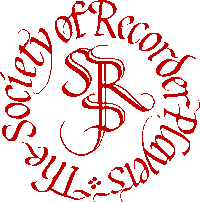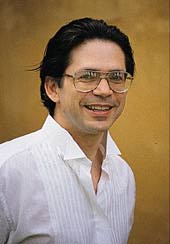 THE SOCIETY OF RECORDER PLAYERS
THE SOCIETY OF RECORDER PLAYERS
President: Sir Peter Maxwell Davies CBE
Registered Charity No. 282751
EDINBURGH BRANCH
New Landscapes for the Recorder  David Bellugi
David Bellugi
(with a “virtual” orchestra of recorders)
AUGUSTINE UNITED CHURCH
George IV Bridge, Edinburgh
Sunday 8 November 1998 at 6.00 p.m.
In association with Musical Italia 98
Programme £2.50
Concession £1.00
PROGRAMMME
Three Klezmer tunes: (arranged by D. Bellugi, 1991)
Roumanian Horra and Bulgar
Frailach (A. Olshanetsky)
Gypsy Bulgar
Five Renaissance pieces:
C. Gervaise: Bransle de Champaigne X (1553)
A. Ferrabosco (1543 – 1588): 4-Note Pavan
C. Gervaise: Bransle Gay III & VI
Diomedes Cato (?) (1570 – after 1607): Dolores Mortis
F. Caroubel: Three Gavottes
Leo Brouwer (1939):
Paisaje cubano con rumba (1985)
Juan Del Encina (1468 – 1529):
Pues que ya nunca nos veis
Triste Spagna
Amor con fortuna
Ay, triste que vengo
Giovangiacomo Gastoldi (c1550 – 1622?):
Speme Amorosa Amor Vittorioso
Franz Joseph Haydn (1732 – 1809):
[pieces written for a musical clock]Vivace, Andante, Vivace, Menuett, Allegro moderato, Allegro ma non troppo, Fuge, Allegro
Johann Sebastian Bach (1685 – 1751)
from the Musical Offering, 1747
Canon a 2 Per tonos
PROGRAMME NOTES:
The music in this programme is presented in a very unusual way: the latest in modern digital technology gave me the opportunity to create a “virtual” orchestra in which I not only play all of the instruments but am also arranger and conductor. The orchestration of this accompaniment uses choirs of instruments, like the “registration” on an organ, where one note may be played by several different instruments in different octaves.
Klezmer music, aptly defined by the great Giora Feidman as “Jewish Soul Music,” owes its particular oriental flavor to the use of various modes which employ the distinctive interval of the augmented 2nd (for example: D-Eb-F#-G-A-Bb-C#-D).
The Renaissance dance form as exemplified by Gervaise has the remarkable characterstic of an almost total absence of musical dissonances. The widespread popularity that this music enjoyed in its day, as well as its pleasing structural and melodic simplicity, make this music an interesting correlative to modern “pop” music. Improvising diminutions or divisions (a particular form of musical variations) makes this music all the more fun to play and listen to.
Dolores Mortis by Diomedes Cato is an elegant example of an instrumental setting of a profoundly moving vocal music.
Paesaje cubano con rumba by Leo Brouwer – Cuban guitarist, composer and conductor – is based on a compositional technique (known as minimalism) in which rhythmical “cells” are superimposed. In the case of Paesaje, these rhythmical cells become more and more complex and dense through mathematical modulations.
Juan Del Encina, a contemporary of Christopher Columbus, was a Spanish poet, playwright and composer. His music – a definite precursor of Renaissance polyphony (at least a generation ahead of his time) – freely uses modes, melodies and rhythms of popular Castilian music. On this note: the recorder, as I see it, has a close relationship to certain folk and ethnic instruments whose music stems from an oral tradition: indeed, much of Early Music either re-elaborates aspects of popular culture or becomes synonymous with it. Encina, for example, freely borrows from popular Castilian culture, while Gervaise’s branles are examples of notated folk music.
The Libro dei 15 Balletti da cantare o sonare con ogni sorte di stromenti [Book of 15 ballads to be sung or played by every kind of instrument] by Giovangiacomo Gastoldi, was one of the first commercial success stories of musical printing history. It was printed in at least 14 different editions and was known throughout Europe. It is undoubtedly ingenious musical writing of graceful simplicity.
The music of Franz Joseph Haydn presented in this programme is a selection of pieces that he composed for musical clocks (meaning a mechanical musical instrument: an early form of midi sequencer!). These pieces are a joyful synthesis of late eighteenth-century musical styles.
In Bach’s Musikalisches Opfer of 1747 (BWV 1079) we find this Canon a 2 Per tonos that includes the Latin subtitle: Ascendenteque Modulatione ascendat Gloria Regis which means “as the modulations increase in pitch so may the Glory of the King.” Like most of the canons from the Musical Offering, this is a canon over a cantus firmus, (in this case the cantus firmus is an embellished version of the melody supposedly played by Friedrich the Great). The 2 part canon (written in counter-point to the cantus firmus) is at the fifth. Bach modified the Cantus firmus so that it’s melodic line ends exactly one tone higher than it begins, therefore it modulates up one whole step each time the cantus firmus is played. I have chosen to stop the modulations after one octave, therefore after 6 whole-tone modulations, taking us through C minor, D minor, E minor, F# minor, G# minor, a#/Bflat minor and back to C.
For technical buffs – equipment used: TascamÔ DA-30 and DA-88 ProtoolsÔ , DeckÔ and Sound DesignerÔ on a Macintosh microphones: NeumannÔ U87, U89, fet SM69 (stereo), AKGÔ “Tube” LexiconÔ 300
David Bellugi
BIOGRAPHICAL MATERIAL:
David has a B.A. in Applied Musicology which he received Summa cum Laude from the University of California at San Diego, where he studied with Bernhardt-Ambros Batschelet (flute), Robert Erickson and Bernard Rands (composition), Anthony Newman (harpsichord), Thomas Nee (conducting), and Bertram Turetzky (advisor for musicology). He continued his musicological research in Early Music performance practices under the guidance of Antoine Geoffroy-Dechaume (a disciple of Arnold Dolmetsch) in Paris.
As soloist David has performed with many orchestras including: the Italian Radio Symphony, Radio France-Paris, Radio France-Lille, Radio della Svizzera Italiana, as well as with the orchestras of Bari, Cagliari, Cordoba (Spain), Parma, Firenze, Harvard University, Milan, Naples, Padua, Palermo, Sanremo and Turin. He has performed in recitals and concert/lectures in Australia, Austria, Belgium, Canada, England, France, Germany, Greece, Israel, Italy, Portugal, Scotland, Spain, Switzerland, U.S.A. and Jugoslavia. His engagements for the next two years include performances in Australia, Austria, England, Germany, Italy, Japan and the USA.
He has premiered various works (Luciano Berio, Nuccio D’Angelo, Ugalberto de Angelis, Riccardo Luciani, Carlo Prosperi, and Giulio Viozzi have dedicated works to Bellugi) and has appeared successfully as conductor-soloist. In 1999, in collaboration with Italian actor Carmelo Bene, he will premiere a work written by Gaetano Giani-Luporini.
David teaches Recorder at the Florence National Conservatory in Italy where he has been living for the past 20 years.
DISCOGRAPHY:
David Bellugi Landscapes FRAME FR9506-2
Leo Brouwer presents Vivaldi: Cardellino FRAME FR9405-2
Orchestra del Chianti Vivaldi and Luciani Concertos FRAME FR01C93
A. Riccardo Luciani Contemporary Classics Primrose PRCD 071
Berry Hayward Consort Telemann Auvidis, BNL 112849
Berry Hayward Consort Juan Del Encina Auvidis, BNL 112848
Berry Hayward Consort Ricercare Auvidis, BNL 112840
Berry Hayward Consort Seicento Auvidis, BNL 112804
Berry Hayward Consort Trecento Auvidis, BNL 112803
Berry Hayward Consort La Messe des Fous Auvidis, BNL 112746
Berry Hayward Consort Carmina Burana Auvidis, BNL 112763
Berry Hayward Consort Renaissance Auvidis, BNL 112764
Berry Hayward Consort La Croisade des Enfants MILAN CD CH 359, RC650
Berry Hayward Consort El Llibre Vermell de Montserrat ERATO 88047
Carmelo Bene Lectura Dantis CGD 20283
Trio Fiorentino Musica Trovadorica… Ricordi COLP 3625
Trio Fiorentino Dal Medioevo al Barocco Ricordi COLP 3610
Universal Music Ensemble Musiques du XIVe Le Kiosque d’Orphée 810509

